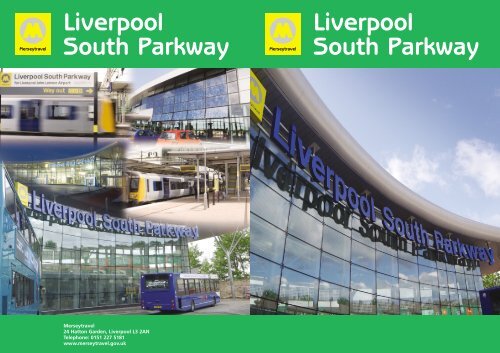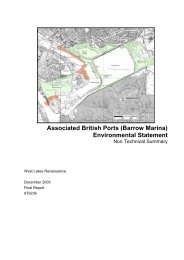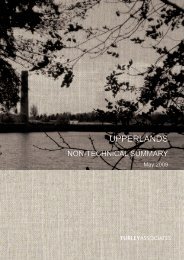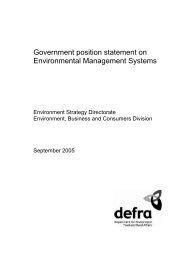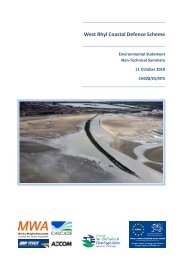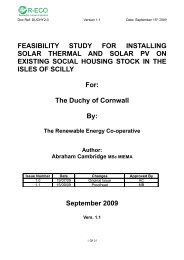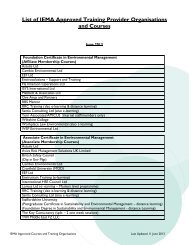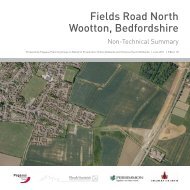Liverpool South Parkway Liverpool South Parkway
Liverpool South Parkway Liverpool South Parkway
Liverpool South Parkway Liverpool South Parkway
- No tags were found...
You also want an ePaper? Increase the reach of your titles
YUMPU automatically turns print PDFs into web optimized ePapers that Google loves.
<strong>Liverpool</strong><strong>South</strong> <strong>Parkway</strong><strong>Liverpool</strong><strong>South</strong> <strong>Parkway</strong>Merseytravel24 Hatton Garden, <strong>Liverpool</strong> L3 2ANTelephone: 0151 227 5181www.merseytravel.gov.uk
Merseytravel, making Europe’smost modern interchangeFrom past to present<strong>Liverpool</strong> <strong>South</strong> <strong>Parkway</strong> (LSP) joins together the twostations of Allerton and Garston.The St Helens and Runcorn Gap Railway opened AllertonStation on 15th February 1864.Garston Station, which was situated 300 metres fromwhere LSP now sits, was opened ten years later in 1874by the Cheshire Lines Committee Railway.LSP from conception to realityIn the mid 1990s when <strong>Liverpool</strong> Airport was expanding,Merseytravel and its partners looked at various options forimproving public transport to the area.A direct rail link was considered but was found tobe hugely expensive and impractical so seriousoptions had to be explored to find analternative way of linking publictransport effectively to the airportand the many jobs that werebeing created in the area.The result was the completerefurbishment andtransformation of AllertonStation (pictured more recentlyright) and the movement ofGarston station (below) 300metres from its previous siteinto the main scheme.In 2002 consultants wereappointed to develop anddesign a stunning, state-ofthe-artlandmarkinterchange that could linkthe rail network withbuses, taxis and the airportand provide a park and ridefacility for <strong>South</strong> <strong>Liverpool</strong>.Preliminary works started in January 2004 andconstruction began in earnest in July 2004. The bridgefrom the main LSP building to the former Allerton stationplatform was lifted into place on Christmas Day 2004.<strong>Liverpool</strong> <strong>South</strong> <strong>Parkway</strong> wasopened to the public on Sunday11th June 2006.Unique, futuristicand changing theface of publictransport designAs one of Merseytravel’s biggestconstruction projects, the £32 million<strong>Liverpool</strong> <strong>South</strong> <strong>Parkway</strong> Interchange is revolutionisingpublic transport in <strong>South</strong> <strong>Liverpool</strong>, providing fast andefficient links to <strong>Liverpool</strong> John Lennon Airport as well asaccess to thousands of jobs.The eco-friendly interchange, with its futuristic design, canboast a number of unique features.Award winning design<strong>Liverpool</strong> <strong>South</strong> <strong>Parkway</strong> has already won majorenvironmental awards for its use of building techniques –and for its potential contribution to the regeneration ofthe Speke and Garston Pathway areas – some more thana year before it even opened!Merseytravel beat 30 other entrants – includinginternational and multinational organisations – to benamed national champion in the transport and freightcategory of the Green Apple Awards.Clean, green and sustainableThe sustainability elements and the complete integrationbetween the various forms of transport are some of thebest examples of their type in the country and fascinatingelements of the project.The use of waste blastfurnace slag instead ofcement, saved 310tonnes of CarbonDioxide (CO 2 ) ascompared to theproduction of ordinarycement.Rainwater harvestingsaves 700,000 litres ofmains water per year.The roof uses 2.3 tonnes of recycled aluminium.Forest Stewardship Council (FSC) certified wood ensuredall timber products came from a responsibly managedforest.Solar photovoltaic cells on south facing windows providesome of the electricity and saves 1.5 tonnes of CO 2 a year.Geothermal heatpumps use 18100-metre deep boreholes which, althoughmore expensive toinstall, can savebetween 30 and 60 percent on costscomparedwithconventionalsystems.Accessible to allMerseytravel’s own Access Officer, himself a wheelchairuser, worked closely on the development of the project.As a result detailed design features include easy accessdoors, variable height ticket counters, colour contrastdesign features to assist people with low vision, accessibleWCs, high visibility signage, induction loops systems forpeople with impaired hearing and a visible staff presenceto assist all passengers.Linking transport togetherMajor features of <strong>Liverpool</strong> <strong>South</strong> <strong>Parkway</strong> include asingle integrated booking office and passengerinformation and enquiry point; real-time information forflights at the airport, buses and trains displayed side byside, secure cycle storage, incorporated bus and taxi stopsand a 240 space park-and-ride car park free to users ofthe facility.A high frequency bus shuttle runs to <strong>Liverpool</strong> JohnLennon Airport. LSP is a secure and safe environmentthanks to CCTV and customer information systems.WorkingtogetherA steering group,headed by Merseytravel,oversaw the project. Themembers included:<strong>Liverpool</strong> City Council;Network Rail; <strong>Liverpool</strong>Land Development Company; Government Office NorthWest; <strong>Liverpool</strong> John Lennon Airport; First North Westernand Serco Nedrail who are the holders of the MerseyrailElectrics and Northern Rail franchises.The Engineer for the works for the project was NeilScales, Chief Executive and Director General ofMerseytravel.Architects on the project were Jefferson Sheard and themain contractors were Edmund Nuttall, one of Britain’slargest civil engineer contractors.While they can lay claimto building Merseyside’smost recent innovativeproject, Edmund Nuttallhave a long establishedlink with the region, theywere also responsible forbuilding the Liver Buildingand the first MerseyTunnel.Spotlight on MerseytravelMerseytravel has achieved Centre of Excellence statusfor integrated public transport, transport planning andthe delivery of public transport schemes.It was voted Passenger Transport Authority of the Yearin 2004 and in 2005.Merseytravel aims to provide Merseyside with “anintegrated public transport system accessible to all” andMerseytravel’s reputation as a leading authority onenvironmental issues is encapsulated in the planningand building of <strong>Liverpool</strong> <strong>South</strong> <strong>Parkway</strong>.
<strong>South</strong> <strong>Liverpool</strong> Football ClubA club rich in history<strong>Liverpool</strong> <strong>South</strong> <strong>Parkway</strong> is on the site of theformer <strong>Liverpool</strong> <strong>South</strong> Football Club, a clubrich in history and famous for producingsome of Merseyside’s most famoushomegrown football talents.Founded in 1898, <strong>South</strong> <strong>Liverpool</strong> Football Clubbegan life in the County Combination League Two.Tasting SuccessThe club tasted quick success, winning the league in the1912/13 season and gaining promotion to League One.The club were forced to disband in 1921 when the groundthey were playing on was needed for oil burning vesselsafter World War One.In 1935, <strong>South</strong> <strong>Liverpool</strong> Football Club was reformed andfound a new home at Holly Farm in <strong>Liverpool</strong>.The site of a former dairy business, the land was takenover by the club and a small stadium was built, funded bydonations of £1,400 from the increasingly excited public.In fact, donations were so plentiful, the public werelimited to contributing £10 each! The money donated wasenough to build a 15,000 capacity stadium and amember’s clubhouse on the site.A Community ClubIt was at this time that the club decided on its name,<strong>South</strong> <strong>Liverpool</strong> Football Club, and it successfully appliedto the Lancashire County Combination League.One of the first matches to be played, at what was thenknown as Holly Park, was a friendly starring Evertonprofessional footballers Dixie Dean and Ted Critchley andall proceeds went to charity.<strong>South</strong> <strong>Liverpool</strong> Football Club won the Welsh Cup in 1939and soon withdrew from the Lancashire CountyCombination League to join the Cheshire CountyLeague.For three seasons in the run up to theSecond World War, from 1936 through to1939, the club tasted huge success,becoming league champions – anachievement matched by only one otherfootball club, Everton FC.It was during this season that Joe Roscoe became <strong>South</strong><strong>Liverpool</strong> FC’s highest goal scorer with a record-breaking 70goals in the 1938/39 season, a clear ten goals more than theprevious record held by Dixie Dean of 60 goals in the 1927/28season.History Makers<strong>South</strong> <strong>Liverpool</strong> Football Club made history on 28th September1949 by playing the first match in the world on a floodlit pitch.To celebrate the world first, <strong>South</strong> <strong>Liverpool</strong> FC invited theNigerian national football team over for a friendly match.The commentator on the day was Ken Wolstenholme, theman behind one of the most famous sporting catchphrases ofall time during the 1966 World Cup Final: "They think it’s allover…it is now!"Both teams graced the pitch, <strong>South</strong> <strong>Liverpool</strong> in their red andwhite shirts, black shorts and football boots against theNigerian players, who sported cloth sacks on their feet!During the game the footballs had to be painted white, sothey were easy to see against the dark background of themuddy pitch. By half-time <strong>South</strong> <strong>Liverpool</strong> FC were trailing2-0 to the talented visitors.The fight back came from <strong>South</strong> <strong>Liverpool</strong> FC in the secondhalf and the game finished 2-2, in front of a crowd of morethan 13,000 fans.The match set a standard for football around the world andsaw a turning point in the history of the club. It meant <strong>South</strong><strong>Liverpool</strong> FC could play on the floodlit pitch on Friday eveningaway from the lure of the neighbouring footballing giants ofEverton at Goodison Park and <strong>Liverpool</strong> at Anfield.Fire DamageIn 1950, the club suffered a major fire in which the main standwas destroyed. Arson was suspected but never proven. Theblaze gave the club the chance to rebuild and, shortly after1950, a new stand and new dressing rooms were built.In 1962, ex-Everton footballer Alan Hampsonbecame player/manager at the club. Hisefforts brought the club back into the limelightand it was under his management that theclub were finally crowned champions of theLancashire Combination League in 1965.After re-joining the Lancashire Combination League,<strong>South</strong> <strong>Liverpool</strong> FC had a series of promotion andrelegation battles from division one and two of theleague. They were finally promoted back to division onein 1952.In the 1968/69 season, <strong>South</strong> <strong>Liverpool</strong> became thefounder members of the Northern Premier League, whichthey played in until the club disbanded in 1991.Famous Faces<strong>South</strong> <strong>Liverpool</strong> FC has seen many famous faces grace itspitch. Brian Kettle, who later went on to play for<strong>Liverpool</strong> FC was one of the stars, as well as Jimmy Case,who would soon go on to become a <strong>Liverpool</strong> legend.A young man by the name of John Aldridge was alsobrought to the club in 1976 for the princely sum of just£11! He went on to become one of <strong>Liverpool</strong>’s all timegreatest goal scorers.The club suffered fire damage in 1976 and1984 and a number of famous players,including <strong>Liverpool</strong>’s Phil Thompson,joined in the rally to raise money for thenew stand appeal in 1984.In 1989 the club suffered yet anothermajor fire and the members club wasdestroyed, making the ground unsafe.Further vandalism of the ground forcedits closure in 1990.<strong>South</strong> <strong>Liverpool</strong> FC looked to Warrington for support toground share and to keep the name of the club alive.However, it never worked out.Last Throw of the DiceThe final throw of the dice was for the club to seekplanning permission for a new ground at Wavertree Park.However, the plans met huge public opposition and hadto be scrapped.The club once graced by some of Merseyside’s bestplayed its final season (1990/91) at Bootle’s Bucks Parkbefore disbanding permanently in 1991.Background courtesy of Hyder Gareth Jawad from the book "Rise and Fall of<strong>South</strong> <strong>Liverpool</strong> Football Club – Holly Park, The Lost Years".Pictures courtesy of the <strong>Liverpool</strong> Daily Post and <strong>Liverpool</strong> Echo archives.
A look back at Garston andAllerton Stations


